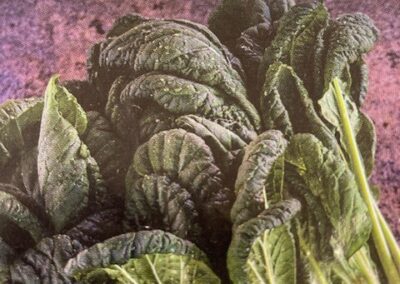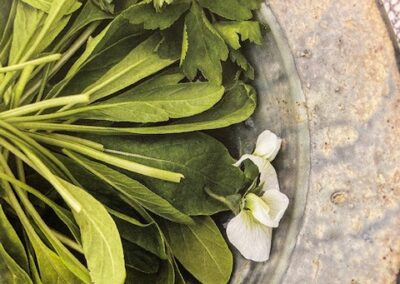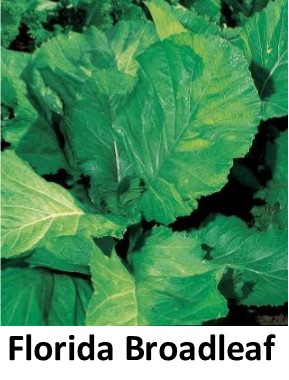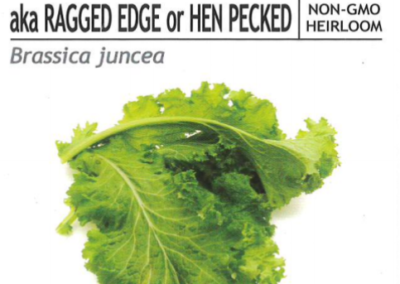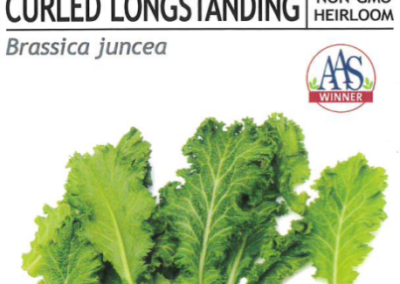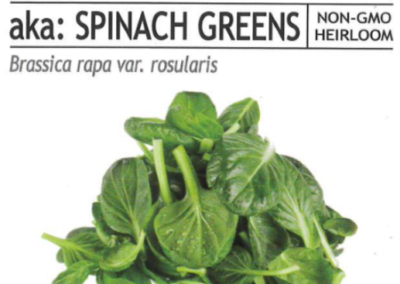
Mustard
Mustard’s spicy, peppery flavor makes it good to use in many cuisines. It is excellent in salads or cooked in stir-fries and casseroles. Its seeds are used to make the condiment mustard. According to WebMD, mustard has more vitamin A than spinach and more vitamin C than oranges.
|
Florida Broadleaf; Old Fashioned; Mibuna Early; Southern Giant; Tatsoi Japanese New: Chijimisai Greens Mizua Beni Houshi |
|
Brassica juncea Brassica rapa: Minbuna Early; Mizuna Beni Houshi; Tatsoi |
| Can be used as a trap crop | |
|
Easy |
|
Intermediate to Difficult |
|
4-5 years if properly stored |
|
Annual |
|
7-14 days |
|
Florida 10-12” tall x 18” spread Mibuna: 12-18” tall ______ 2′ tall (3 listed below) Old Fashioned 16-18” spread S. Giant 18-24” spread Tatsoi 12-14” spread |
|
Mizuna Beni Houshi–Yes |
|
Full sun, but will tolerate part shade |
|
40-55 days Chijimisai: 55 days Mibuna: 21-40 days |
|
February, March, and August |
|
Yes |
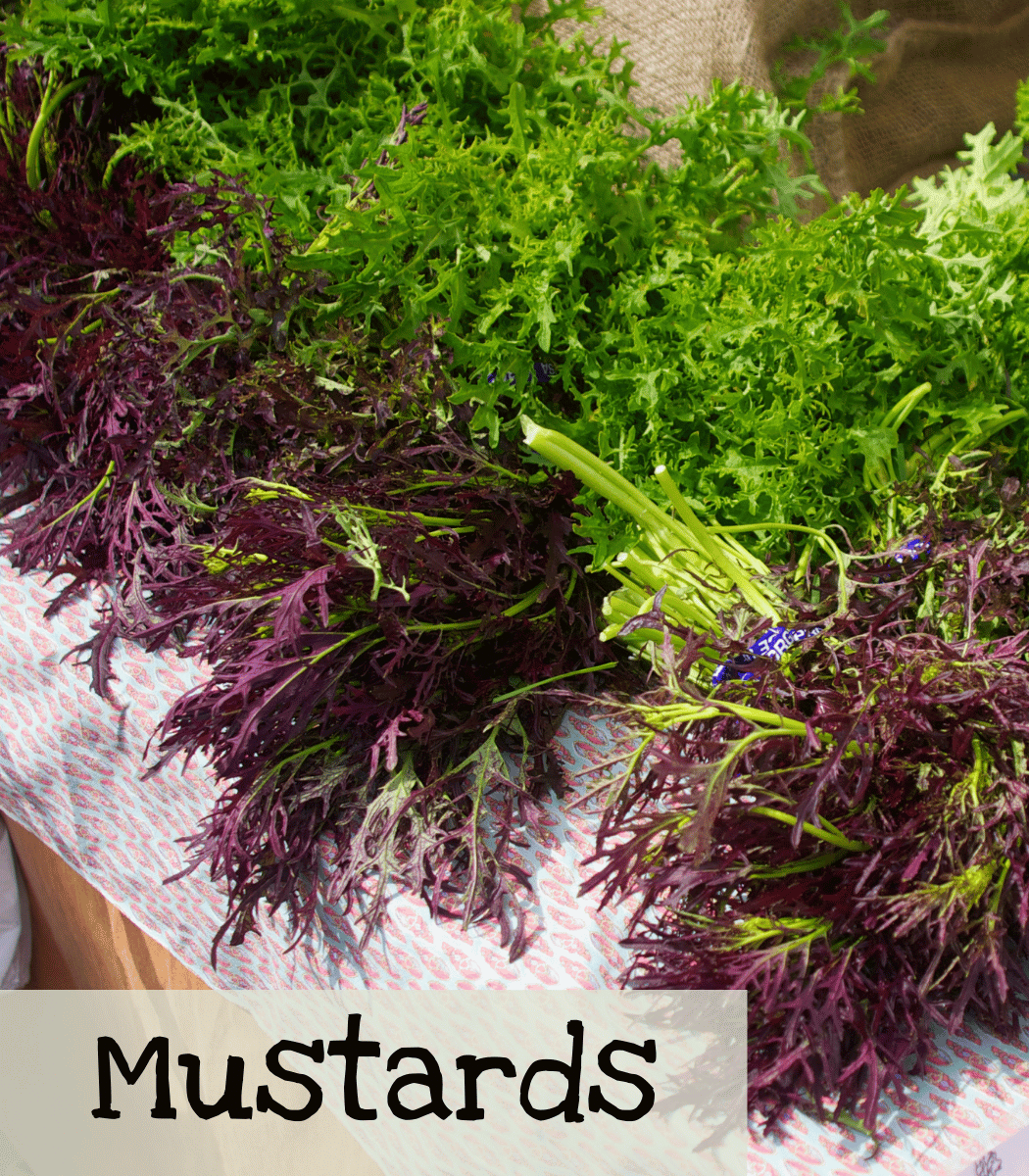
Growing Tips

How to Start
Spring: Direct sow 3 weeks before the last frost date. (Jan 15-Apr 1 for GA)
Fall: Direct sow 4-6 weeks before the first freeze. (Aug 15-Sep 15 GA)
Start Indoors for Trap Cropping. Start soon enough so that the plant is mature/blooming at the time the pests you are trying to contain arrive.
How to Grow
For spring planting, direct sow in full sun 3 weeks before the last frost date. Sow to a depth of ½ inch. Thin to 3 inches apart. For a more steady harvest, plant three weeks apart. For fall crops, direct sow 4-6 weeks before the first freeze. Mustard can be started indoors to get a jump start for succession planting or for use as trap crops.
Care
Keep in mind that mustard greens like cool weather and grow rapidly. They will not grow well in the Summer and become bitter in hot weather. You can fertilize with a balanced fertilizer, but often these vegetables don’t need it in well-amended vegetable garden soil. Mustard greens need 2 inches of water a week.
Harvest
You should harvest mustard greens while they’re still young and tender. Older leaves will get tough and increasingly bitter as they get older. Discard any yellow leaves that may appear on the plant. Once established, mustards will produce edible leaves even when temperatures drop to 30 F and below. But they will bolt and become bitter in hot weather. Mibuna can be harvested when the leaves are 3-6” for baby greens or 12-18” for a mature harvest.
Using as a Trap Crop
Mustard can be used as a trap crop to protect cabbages from common pests. Follow one of the planting methods discussed in “Trap Cropping”. The link is below. When using mustard in this fashion, you want to start it soon enough so that it is blooming when the pests arrive. Depending on when you are starting the crop you wish to protect, this could mean planting mustard in the fall. For example, if planting the main crop (cabbage) in the spring the mustard may need to be planted the previous fall so that it will bolt as the cabbage is growing. This kind of planning is one reason why using companion planting for pest control is so much easier.
Seed Saving

Isolation Distance
Mustards are wind-pollinated. They will cross with other mustard varieties. Separate by 1 mile for reliable distance isolation.
Instructions
Once established, mustards will produce edible leaves even when temperatures drop to 30 F and below. But they will bolt and become bitter in hot weather.
Allow seeds to mature and dry on the plants before harvesting. Store them in a dry place and wait until they are thoroughly dry. Seeds and finer chaff are easy to separate by a variety of methods. One way is to use two screens of varying mesh, one a little smaller than the seeds and the other a little larger. The first screen lets anything smaller than the seeds fall through, and the second lets the seeds through and stops anything larger.
Features
- Mibuna Early is super cold-tolerant but hates the heat.
- Mizuna Beni Houshi is adapted to both heat and cold extremes but becomes more flavorful after a frost. The red stems have the same antioxidants as blueberries. It is good raw in salads and for several harvests. This Japanese mustard is also not as susceptible to the normal pests that mustards deal with. That being said these pests can still be a problem.
- Florida Broadleaf is quick growing making it popular in the South. It’s large flavorful leaves are perfect for salads and sandwiches. Heirloom.
- Old Fashioned: Heirloom. The leaves are often steamed but they are also good in salads. The leaves are long, narrow, and ruffled.
- Southern Giant is an old heirloom from the South. It is slow to bolt and mild in flavor.
- Tatsoi is best eaten raw and mixed with other greens. It has small spoon-shaped leaves that are mild and sweet with tangy, nutty nuances.
- Chijimisai Greens is a great spinach substitute and is considered a superfood. It is high in vitamin A. It is both heat and cold-tolerant. It is very versatile and can be in stir-fries, soups, salads, stuffed in pasta as a spinach substitute, and on top of pizza.

- Be aware, that sometimes mustards can bolt with immature flowers (possibly not seed-producing) if planted at the wrong time.
- Mustards planted in the Fall will bolt the following year.
- Pick ‘baby’ leaves at 20-25 days and harvest the entire head at 40-55 days.
- Mustard can be used as a trap crop.
You May Also Like:
Companion Planting: How to use flowers to help control pests.
Trap cropping: How to keep pests out of your main crop.

